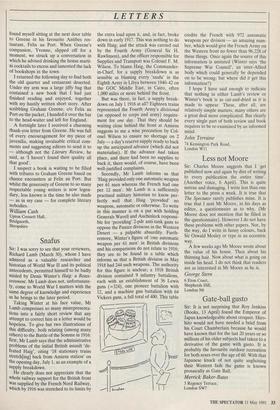Snafus
Sir: I was sorry to see that your reviewers, Richard Lamb (March 30), whom I have admired as a valuable researcher and historian of World War II and its political antecedents, permitted himself to be badly misled by Denis Winter's Haig: a Reass- sessment. Mr Lamb does not, unfortunate- ly, come to World War I matters with the same degree of knowledge and experience as he brings to the later period.
Taking Winter at his face value, Mr Lamb compresses so many misrepresenta- tions into a fairly short review that any attempt to correct him in a letter would be hopeless. To give but two illustrations of this difficulty, both relating (among many others) to the Battle of the Somme in 1916: first, Mr Lamb says that the administrative problems of the initial British assault 'de- feated Haig', citing '18 stationary trains stretching] back from Amiens station' on the opening day, July 1, as an example of a supply breakdown.
He clearly does not appreciate that the whole railway support for the British front was supplied by the French Nord Railway, which by 1916 was stretched to its limits by the extra load upon it, and, in fact, broke down in early 1917. This was nothing to do with Haig; and the attack was carried out by the Fourth Army (General Sir H. Rawlinson), and the officer responsible for Supplies and Transport was Colonel F. M. Wilson. To blame Haig, the Commander- in-Chief, for a supply breakdown is as sensible as blaming every 'snafu' in the Eighth Army in Libya between 1940-42 on the GOC Middle East, in Cairo, often 1,000 miles or more behind the front.
But was there, in fact, a supply break- down on July 1 1916 at all? Eighteen trains represented the Fourth Army's divisional (as opposed to corps and army) require- ment for one day. That they should be waiting close behind the front at Amiens suggests to me a wise precaution by Col- onel Wilson to ensure no shortage on 2 July — a day's reserve supply ready to back up the anticipated advance (which did not materialise). If the advance had taken place, and there had been no supplies to back it, there would, of course, have been well-justified complaints. Secondly, Mr Lamb informs us that `Haig provided only one automatic weapon per 61 men whereas the French had one per 12 men'. Mr Lamb is a sufficiently practised military historian to know per- fectly well that Haig 'provided' no weapons, automatic or otherwise. To write in this manner is on a par with holding Generals Wavell and Auchinleck responsi- ble for 'providing' 2-pdr anti-tank guns to oppose the Panzer divisions in the Western Desert — a palpable absurdity. Furth- ermore, Winter's figure of 'one automatic weapon per 61 men' in British divisions and his comparisons do not relate to 1916; they are to be found in a table which informs us that a British division in May 1918 had 244 such weapons. The authority for this figure is unclear; a 1918 British division contained 9 infantry battalions, each with an establishment of 36 Lewis guns (=324), one pioneer battalion with 12, and a machine gun battalion with 64 Vickers guns, a full total of 400. This table credits the French with 972 automatic weapons per division — an amazing num- ber, which would give the French Army on the Western front no fewer than 96,228 of these things. Once again the source of this information is unstated (Winter says 'the Supreme War Council', an inter-Allied body which could generally be depended on to be wrong; but where did it get this information?) I hope I have said enough to indicate that nothing in either Lamb's review or Winter's book is as cut-and-dried as it is made to appear. These, after all, are relatively simple matters; many others are a great deal more complicated. But clearly every single part of both review and book requires to be re-examined by an informed mind.
John Terraine
74 Kensington Park Road, London W11


























































 Previous page
Previous page